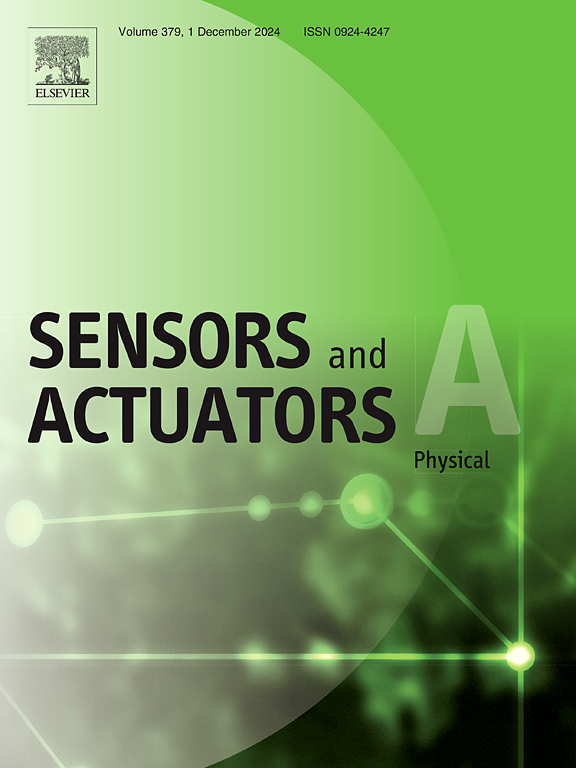Somatosensitive inverse artificial muscle for wearable robots
IF 4.1
3区 工程技术
Q2 ENGINEERING, ELECTRICAL & ELECTRONIC
引用次数: 0
Abstract
Soft robotics have demonstrated significant potential in rehabilitation and wearable devices, attributed to their intrinsic compliance and safe interaction with humans. However, developing soft wearable robots with large deformation to assist the movement of human joints and simultaneously sensing the deformation remains challenging. This paper introduces a novel design of a type of compact somatosensitive inverse artificial muscle (SIAM) by directly coating sensing elements on the surface of soft actuators. We provided a theoretical model and conducted finite element simulations to analyze the impact of various parameters on the resistance of the proposed SIAM, and verified the model experimentally. Preliminary results show that the proposed SIAM is able to perform 200 % elongation with real-time length feedback. The maximum and minimum resistance of the SIAM changed by less than 5 % even after over 1000 working cycles. We further validated the effectiveness of the proposed SIAM on wearable robots in two working scenarios: elbow flexion rehabilitation and wrist flexion rehabilitation with the reduction of corresponding muscles’ activation levels from 100 % to 22.2 % and 24.3 %, respectively. Meanwhile, the SIAM could detect the joint angles with a maximum error of 2 degrees. This work provides an alternative design for soft wearable robots with high-fidelity and endurable sensing abilities.
用于可穿戴机器人的体敏逆人工肌肉
软机器人由于其固有的顺应性和与人类的安全互动,在康复和可穿戴设备方面显示出巨大的潜力。然而,开发具有大变形的软性可穿戴机器人来辅助人体关节运动并同时感知变形仍然是一个挑战。本文介绍了一种将传感元件直接涂覆在软致动器表面的紧凑型体敏逆人造肌肉(SIAM)的新设计。我们建立了理论模型,并进行了有限元仿真,分析了各种参数对所提出的SIAM电阻的影响,并进行了实验验证。初步结果表明,在实时长度反馈的情况下,所提出的SIAM可以实现200 %的伸长率。SIAM的最大和最小电阻在超过1000个工作循环后变化小于5 %。我们进一步验证了SIAM在可穿戴机器人两种工作场景下的有效性:肘关节屈曲康复和手腕屈曲康复,相应的肌肉激活水平分别从100% %降低到22.2% %和24.3% %。同时,SIAM可以检测关节角度,最大误差为2度。这项工作为具有高保真度和持久传感能力的软可穿戴机器人提供了一种替代设计。
本文章由计算机程序翻译,如有差异,请以英文原文为准。
求助全文
约1分钟内获得全文
求助全文
来源期刊

Sensors and Actuators A-physical
工程技术-工程:电子与电气
CiteScore
8.10
自引率
6.50%
发文量
630
审稿时长
49 days
期刊介绍:
Sensors and Actuators A: Physical brings together multidisciplinary interests in one journal entirely devoted to disseminating information on all aspects of research and development of solid-state devices for transducing physical signals. Sensors and Actuators A: Physical regularly publishes original papers, letters to the Editors and from time to time invited review articles within the following device areas:
• Fundamentals and Physics, such as: classification of effects, physical effects, measurement theory, modelling of sensors, measurement standards, measurement errors, units and constants, time and frequency measurement. Modeling papers should bring new modeling techniques to the field and be supported by experimental results.
• Materials and their Processing, such as: piezoelectric materials, polymers, metal oxides, III-V and II-VI semiconductors, thick and thin films, optical glass fibres, amorphous, polycrystalline and monocrystalline silicon.
• Optoelectronic sensors, such as: photovoltaic diodes, photoconductors, photodiodes, phototransistors, positron-sensitive photodetectors, optoisolators, photodiode arrays, charge-coupled devices, light-emitting diodes, injection lasers and liquid-crystal displays.
• Mechanical sensors, such as: metallic, thin-film and semiconductor strain gauges, diffused silicon pressure sensors, silicon accelerometers, solid-state displacement transducers, piezo junction devices, piezoelectric field-effect transducers (PiFETs), tunnel-diode strain sensors, surface acoustic wave devices, silicon micromechanical switches, solid-state flow meters and electronic flow controllers.
Etc...
 求助内容:
求助内容: 应助结果提醒方式:
应助结果提醒方式:


